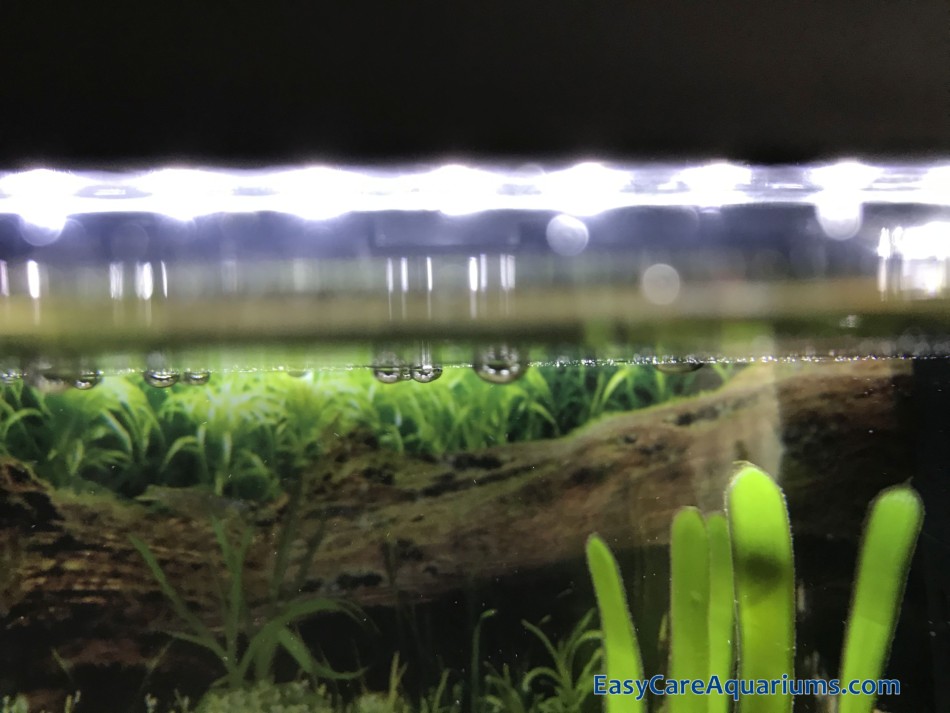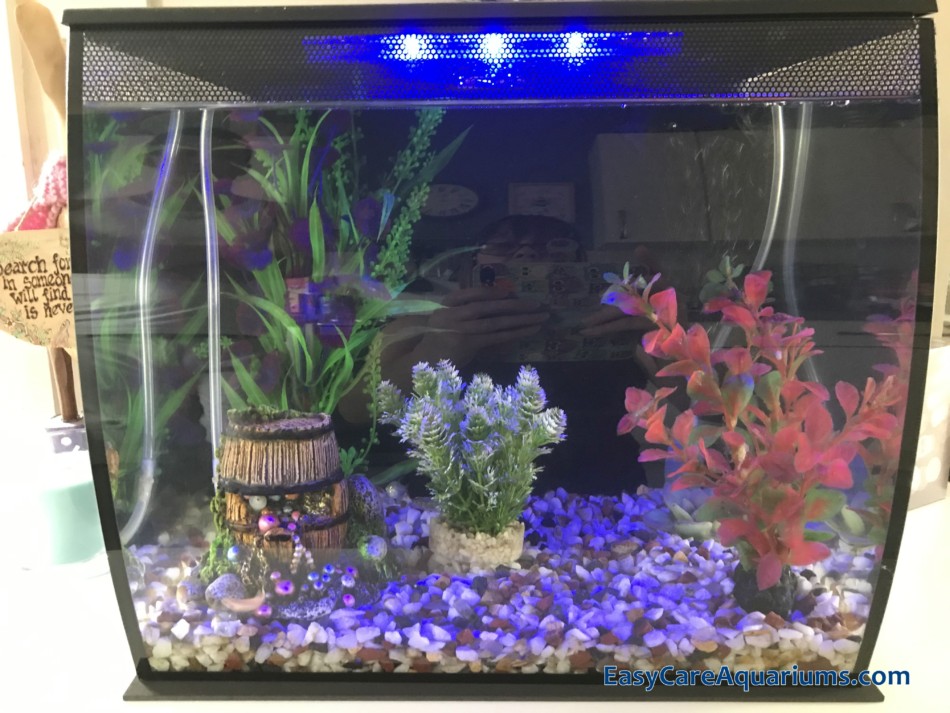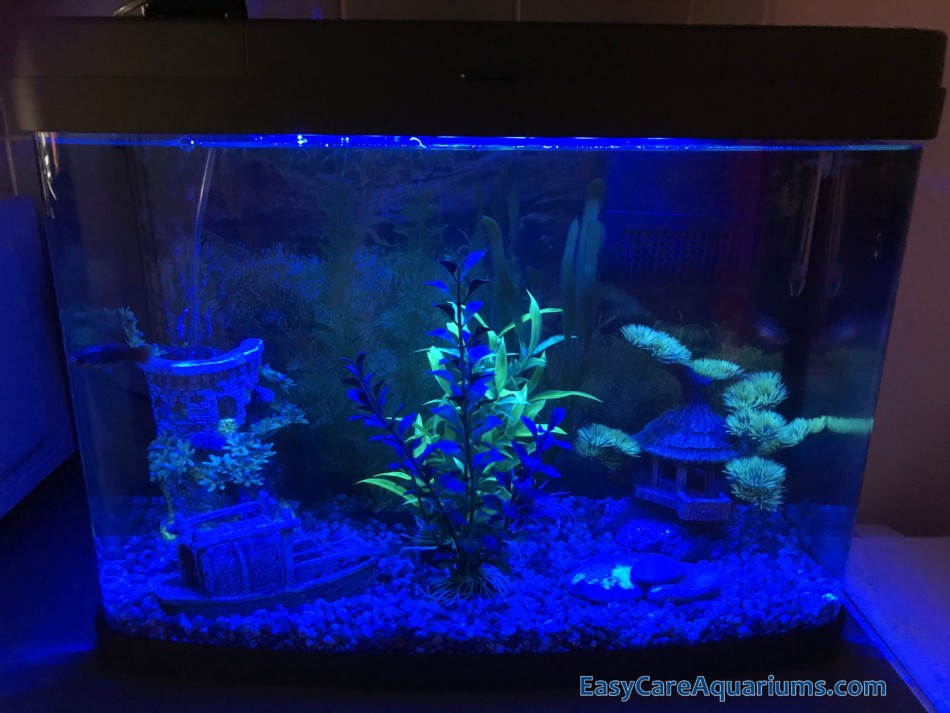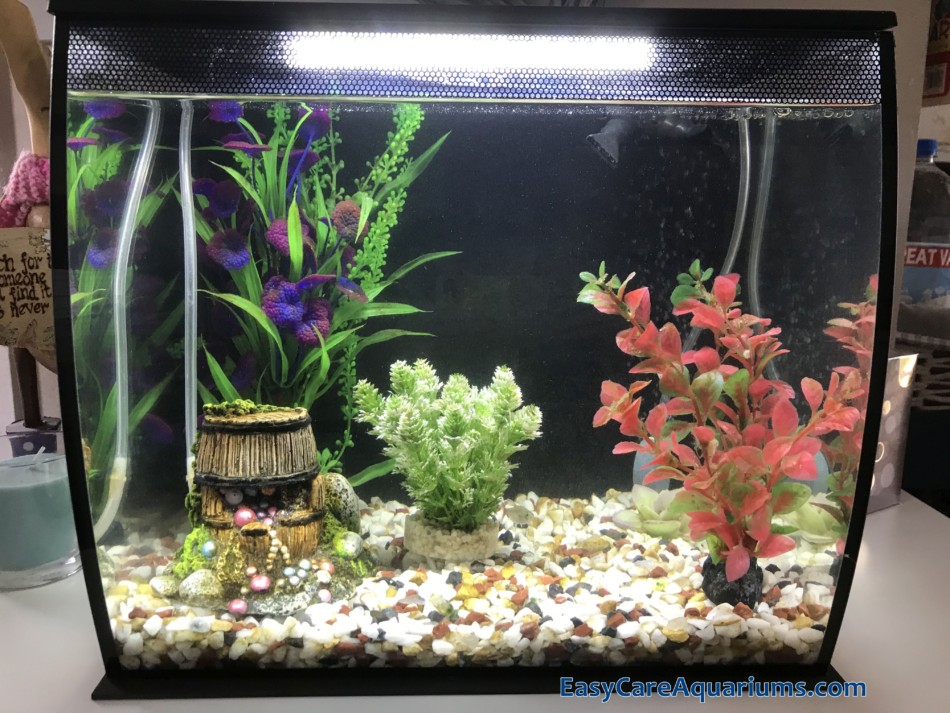This article may contain some affiliate links to products. The links provide me a small percentage of commission but do not cost you anything extra to use. (See full disclosure statement here ).
).
Because it’s unusual to see an unlit fish tank it’s reasonable to assume that most people in the fishkeeping hobby light their aquariums.
But why do we install lights in our tanks and what difference does it make?
There are several answers to this and I’ve put some of them together in this article. Of course you may have your own reasons too for lighting your tank.
Will A Light Make My Tank Look Better?
The first, and probably the most obvious reason for lighting your aquarium, is that having a light in your tank simply makes it look better.
One of the problems with having an unlit tank is that it can end up looking like a black box sitting in the corner of the room. You can’t see much of your plants or tank decorations. And let’s face it, you’ve probably spent a lot of time and effort making the tank look good.
Without a light you’ll get to see even less of your fish. Or any of the other inhabitants of your tank, such as shrimp and snails.
Lack of lighting in an aquarium also makes it more difficult when it comes to monitoring your fish’s health. After all, you need to be able to see your fish clearly to check for signs of illness, bullying or pregnancy. Or even just to check that every one of your fish and their tank mates are getting their fair share of the food.
It’s not practical to have to get a torch/flashlight out every time you want to check on how your fish are doing.
So investing in a tank with an inbuilt lighting system, or adding an independant light to your existing aquarium, is really useful. You can also rig up your own external lighting system. And the good news is that you don’t need to be a DIY expert to do it.
So having a light for your aquarium makes it look better. It will highlight and show off your plants and tank decorations. It makes it a lot easier to keep an eye on your fish and their tank mates. It also increases your enjoyment of your fish because you can see the antics they get up to.
And a light really brings out the colours of your fish so you get to them in their full glory.
After all, the main point of the fishkeeping hobby is to get pleasure from seeing your fish. Otherwise the work of maintaining the tank is just another chore that you could do without.
Watching your fish swim around the aquarium is a great way to relax too. It helps you to unwind after a hard day. It can take your mind off the problems that life often throws at you.
Well it works for me anyway.

Different Kinds Of Tank Lighting
The type of lighting you’ll need for your aquarium is going to depend on what you’re keeping in the tank. So you will need to get some expert advice on the best type of light if you keep, or are planning to keep, something a little more ‘exotic’ than the Platy fish and Amano shrimp that I’ve been keeping in my aquariums to date.
A lot of tanks have their own in-built lighting system in the hood. But if you prefer to set up your own lighting system, either pre-made or home-made, then there’s plenty of tanks for sale that come without an in-built system.
My original starter tank, a 17 litre Marina Pirates aquarium, (I’m a child at heart!) didn’t come with a light. But I did buy the one that was made to fit the dome shaped hood. It wasn’t a very bright light, just 3 LED bulbs on an arched fitting, and it was fine until I moved the tank to a darker corner.
So I bought a brighter light. I replaced the original light with an Interpet 20cm blue and white light that you fix to the hood with either screws, sticky pads or suckers. It’s fully submersible so you can use the suckers to fix the light under the water if you want to. This light is designed for small tanks and despite the dome shaped hood on my tank the light hasn’t fallen into the water yet. It’s a lot brighter in the tank now and the blue/white light really brings out the blood-orange colour in my male Platys.
My larger tank, the one that my son bought me for my birthday, is a Love Fish 40 Litre Panorama Aquarium which came with LED bars built into the hood. And I have the choice of either white or blue light.
When it came to lighting my tiny 12 litre Aqua World Starter tank (I use this as a hospital/quarantine/fry tank) I didn’t buy a pre-made light for it. I already had a flexible desk lamp at home so I went to my local Wilko store and bought an LED bulb to fit it. The lamp sits on top of an upturned plastic cookie jar behind the tank and lights it up through the clear hood. It works really well. And by using a lamp I already had I saved myself some money.
So although I don’t have really big tanks at the moment, or a special fish room (I would love one though!) my tanks do have lighting in one form or another. An in-built one, a pre-made one and a ’home-made’ one.
It doesn’t matter what size aquarium(s) you have, you’re still a fishkeeper. And if you want to light your tank there’s different ways to do it. Just choose what suits you and your fish best.
LED Lights
LED lights are a popular way to light an aquarium. They give off hardly any heat and they’re generally compact in size. They’re often submergible and dimmable too with a choice of lighting colours.
They’re also considered energy saving which is good news for your utility bills.
But LEDs are not the only type of tank lighting available.
Other Kinds Of Tank Lighting
Fish Keepers also use other types of bulbs. The standard fluorescent tube and metal halide bulbs are just two examples. And those that are fortunate enough to have a fish room use all sorts of in-tank and overhead lighting.
I have to admit that while I was looking into different ways to light fish tanks I did get a bit ‘blinded by science’. Light is measured in, what for me, is a very scientific way. Spectrums and Kelvins and so on. It’s all a little above my head so I suggest you get some expert advice if you need a specific type of light for your aquarium.
Despite the ‘science’ lighting your fish tank doesn’t have to be complicated. Just get some good advice about what is suitable for the fish you keep. And don’t forget to take the needs of any shrimp, snails and live plants that share the tank into consideration too.



What Colour Light Is Best For Aquariums?
I think that the answer to choosing the best colour comes down to personal opinion. It’s going to depend on what effect you want the light to have on your tank and its inhabitants.
Different colours of light affect the colours in your tank in different ways. Whether that’s the colour of your fish, plants or tank decorations. Coloured lights have an impact on how it all looks.
Even white light isn’t all the same shade or intensity. As I mentioned earlier, light spectrums and so on, can be a complicated thing if you go into it. But it doesn’t have to be complicated to choose a light for your tank.
And I for one like to keep things simple.
Despite there being many choices in colour when it comes to tank lights, white, red, green and blue seem to crop up most often. Each of these colours is considered to enhance an aquarium in different ways.
The colours your fish are displaying, and also the colours of the plants and decorations in your tank, are likely to influence your choice of lighting colour.
It’s worth getting some advice from your Pet Store or Aquatic Dealer to help you make the most of the lighting in your aquarium.
You could also buy a tank light that has different colour settings.
My daughter has one of these in her fish tank. There’s a wide choice of colours which are changed via a remote control. There’s even a stormy lightning effect. Although that might frighten the fish!
Having a choice of colours in your lighting unit will allow you to play around with what colour you think suits your tank and its inhabitants best. Some tank lighting systems come with this option built in. But you can also buy and install an independent light unit that gives you several choices when it comes to colour.
And if you have fish that prefer to come out when the light is low there’s usually a blue ‘Moonlight’ setting so you can watch your fish when they come out to feed and explore. Or you can invest in an independent tank light that gives off the Moonlight effect for your more nocturnal fish, shrimp or snails. You’ll get the chance to see them all in action rather than missing out because you’re in bed.
So when it comes to lighting your tank there’s lots of options for you to consider and play around with.
Do Live Plants Need A light?
My understanding of live aquarium plants and light is that all plants need at least some light to grow and stay healthy. How much light a plant needs, and for how many hours a day, is going to vary depending on the individual plant’s needs.
Some aquarium plants thrive well in low lighting. Just the natural daylight that enters through the tank glass is enough for them.
Other plants need several hours of brighter light. Whether that’s natural or artificial light, again, will depend on the particular plant.
If you’ve read any of my other articles you’ll know that I have artificial plants in my aquariums. And while I’ve learnt a bit about live aquarium plants, and passed that information on, I don’t (at the time of writing this) have any actual experience of keeping a live planted tank myself.
I am looking to add live plants to my tanks but I just haven’t got there yet. In other words I’m not an expert on how to keep a live planted aquarium.
However, I do know that some plants are easier to keep than others. Whether it’s their lighting needs, the use of fertilizer or how much ‘gardening’ you’ll need to do, the plants can vary in their needs by quite a bit.
So my general advice on this is to make sure that you get some reliable information about the plants that you think will look good in your aquarium before you decide to buy. After all It’s always best to know what the plants will need from you before you head to the checkout
And don’t forget to check if the plants you like best will be suitable for the fish you keep, and also for any shrimp or snails that share the tank with them.

Do Tank Lights Cause Algae?
A small amount of algae is good for an aquarium. A lot of fish, my Platys included, like to nibble on algae to supplement their diet. Or just because it’s what they like to do.
Algae consumes the nutrients in the water to grow in the same way that live aquarium plants do.
Unfortunately algae needs very little of the nutrient content in the tank to grow, and to keep on growing at an alarming rate.
Too much algae is not only unsightly but it’s bad for your fish. It uses up the oxygen in the water which means that your fish will suffer. Along with your live plants and any other inhabitants of your fish tank.
But does your tank light contribute to excess algae growth?
Algae needs light to grow just like any other plant does. But that doesn’t mean that you should just keep your tank light off in an effort to solve the problem.
If you have live plants in your aquarium they will need the light on for several hours a day. Also some fish need light to thrive too.
Then there’s the fact that having a tank light allows you to enjoy seeing your fish.
So what should you do to make sure the light in your aquarium isn’t creating, or adding to, an algae problem?
Well it’s all about getting the balance right. To do this you need to find a happy medium between enough lighting time for your fish and live plants, but not overdoing it so that the algae can take advantage and mess up your tank.
Excess light can mean excess algae.
But It’s Not Just Excess Light That Can Cause Algae
Too much light in an aquarium is not the only cause of unsightly algae. There are some other things to consider if your tank has developed an algae problem. Or you’re just trying to avoid the problem in the first place.
Along with only lighting your tank for the minimum amount of time that’s necessary it’s important not to overfeed your fish. Overfeeding is generally considered the most common factor in the growth of excess algae in home aquariums.
By monitoring your feeding routine carefully, and not overdoing it, you can help reduce your algae problem.
Less uneaten food equals less chance of algae.
Also keeping to your tank maintenance schedule with regular water changes, gravel vacuuming and removing algae from the tank glass and decorations, all help to combat excess algae growth.
As does keeping your tank filtration system properly maintained. The flow around your tank needs to circulate all through the tank. If you have any ‘dead flow zones’ the algae will flourish. So check that the water is moving all around the tank. It may mean you’ll need to rearrange things inside the tank a bit to get things flowing properly. But it will be worth the effort.
You may have to carry out your maintenance more often if you’re fighting an algae issue. But don’t overdo it or you’re likely to kill off the beneficial bacteria that an aquarium needs to stay healthy.
Does Sunlight Cause Algae?
Direct sunlight on aquarium glass is another thing that algae loves. So where you position your tank in the room will make a big difference to how much and how fast the algae in your tank grows.
It’s best to position your tank away from windows and glass doors so that the light coming through doesn’t hit the tank directly. The further the light has to travel to reach the glass the better. Being out of the way of the direct line of incoming daylight is best.
But if that’s not possible just do your best to place the aquarium as far from the light source as possible.
Personally I’ve found that sunlight grows algae in a fish tank faster than artificial light does. But either way you can end up with a problem if there’s too much light.
Keep on top of your tank maintenance too because it all helps to stop excess algae ruining your aquarium.

Should I Turn My Aquarium Light Off At Night?
Nature creates its own periods of light and darkness. It’s just the way that things work when it comes to our planet. Technological progress over the years has given us the ability to decide when it’s light or dark in our own homes. We can control how many hours of light and darkness we want at the touch of a button or switch.
Which is great for us.
But what about your fish?
We can choose when to turn our lights on and off to suit our lifestyles and personal needs. But our fish and any shrimp and snails that we keep, are relying on us to do this for them.
So how many hours of light is best for your aquarium?
The amount of light your aquarium needs daily will depend on the fish and plants that live in the tank. So it’s likely to be a case of finding a happy medium to keep everyone healthy.
You’ll probably need to do a little research on both your fish and plants so you can make your own informed judgement. Then see how things go. You can always adjust the lighting time to suit your own tank if you think you haven’t got it quite right the first time round..
As far as I can tell there doesn’t seem to be any hard and fast rules for lighting time. But between 8-12 hours of artificial tank lighting seems to cover most opinions.
It’s true there may still be light entering through the glass once you’ve turned the tank light off for the day. But it will be a lower level of light. Even if you still have your house lights on it won’t light up the tank at the same intensity that a tank light does.
Because the light level is lower it’s a bit like being outside at the end of the day when the natural light begins to fade. Lower light levels create a winding down period that helps us, as humans, to sleep better. And the same goes for the inhabitants of your aquarium.
Okay, I realise that some fish are active at night and it’s the time when they forage for food. So the darker hours are their time. But the other fish in your tank will use the darkness to rest.
So having this dark time will be beneficial to both those that are more active in the light and those that get going when it’s dark.
It’s likely to be a bit trial and error initially when it comes to gauging how many hours you should light up your aquarium.
However, it’s not a good idea to leave your tank light on 24 hours a day.
Leaving the light on permanently can stress out your fish. If they don’t get enough downtime they are likely to get stressed. And a stressed fish is more prone to illness. Which is not only worrying for you but it can be deadly for the fish itself.
So don’t overdo the lighting.
I know that a tank looks so much better with the light on but you need to get a balance between your enjoyment of seeing your fish in their full glory, and making sure the fish and their tank mates don’t suffer because they are feeling stressed out.
How To Control The Lighting In Your Fish Tank
There are different ways to control the lighting time in your aquarium. It does depend on what type of lighting you’ve already got installed. Or what type of lighting you are planning to add to your tank.
Some tanks with built in lights have a built in timer device already attached to the light unit. So you just follow the instructions to set up the right amount of ‘on and off’ time to suit your fish’s needs.
A lot of tanks though just have simple on/off button(s) in the tank hood. My larger tank has this kind of built in lighting system with the buttons under the feeding flap. The power supply to the lights is linked to the power supply that also runs the filter pump. So there’s only one plug that runs both the filter and the LED light bars.
Which means that I have to manually turn the light on and off every day using the buttons. If I just hit the switch on the wall socket it would turn the filter off too.
If your tank also has this type of basic on/off lighting it doesn’t mean that you can’t automate the on/off cycle. You can get devices that attach between the power supply and the lighting system that let you set a timer.
And if you’ve got dimmable bulbs in your tank, such as LEDs, you can even set the lights to gradually fade in and out at the beginning and end of the day.
Both of my other tanks have independent lighting that I’ve added myself. Which means they have their own plugs that power the lights separately from the filters. An easy way to control the amount of light in these tanks is to add a simple timer device to the light’s own power plug before plugging the whole thing into the mains power supply.
Just like you would if you wanted to set a timer for any other electrical item in your home – a security light for example.
There are probably other ways to automate the light cycle in your aquarium so it’s worth doing a little research to see what suits you best.
Having a timed light cycle is useful for everyday use but it really comes into its own when you go away for work or go on vacation. Not everyone has somebody to come in and take care of their aquarium while they’re away from home.
So sorting out timed lighting periods before you go away means you’ve got one less thing to worry about.

